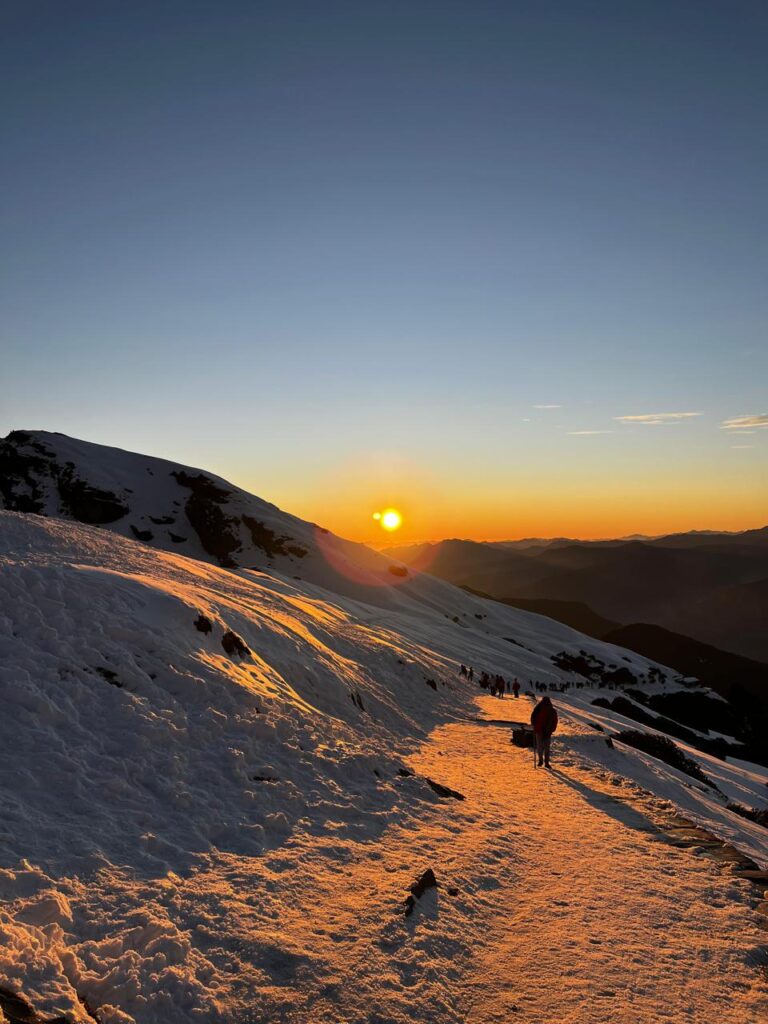Chopta, nestled in the heart of the Garhwal Himalayas, is not just a scenic destination but also a hub for trekking, adventure, and peaceful escapes. Understanding the Chopta weather is essential to make the most of your visit, whether you are planning the Chopta Tungnath trek, a relaxing getaway, or exploring the Himalayas with a Chopta tour package.
The climate in Chopta changes beautifully with the seasons, giving travelers a chance to experience something unique all year round. From March to May, the weather is cool and pleasant, making it one of the best times to visit Chopta. This period is perfect for trekking, camping, and photography, as the skies are clear, and the meadows are alive with wildflowers.
The monsoon season arrives from July to October, bringing lush greenery, mist-covered mountains, and fresh mountain air. While trekking can be slippery during rains, this time is ideal for those seeking solitude and peaceful walks amidst nature.
Winter in Chopta, from November to February, transforms the region into a snowy wonderland. The snow-capped peaks, including the iconic Tungnath Temple and Chandrashila Peak, make the Chopta Tungnath trek and Chandrashila summit trek even more magical. The temperatures can drop below freezing, creating a serene environment for snow lovers and photographers alike.
Planning your visit according to the Chopta weather ensures you enjoy every activity safely and comfortably. With TourMyHoliday Chopta tour packages, you can experience the beauty, spirituality, and adventure of Chopta in the right season — making every trek, sunrise, and meadow walk a memory to cherish.
Whether you’re coming for a quick escape, a spiritual journey, or an adventurous trek, understanding Chopta’s climate helps you make the most of your Chopta tour package and ensures your Himalayan trip is truly unforgettable.

Chopta Tungnath Trek Weather Guide – Plan Your Perfect Trek
The Chopta Tungnath trek is one of the most beloved Himalayan treks for adventure seekers and nature lovers alike. Nestled in the Garhwal region of Uttarakhand, this trek combines serene meadows, dense forests, and the spiritual aura of the Tungnath Temple — the highest Shiva temple in the world. Understanding the Chopta weather is essential for planning a safe and enjoyable trekking experience. Whether you’re booking Chopta trekking packages or planning your Chopta Tungnath trek from Delhi, knowing month-wise conditions will help you make the most of your journey.
March – May: Spring Awakening
- Weather: Pleasant and cool, temperatures range from 10°C to 30°C.
- Highlights: The forests and meadows are alive with blooming flowers. Clear skies provide panoramic views of the Himalayan peaks.
- Trekking Tips: This is the best time for the Chopta Tungnath trek from Delhi for beginners and families. Trails are dry and safe, ideal for trekking, camping, and photography.
- Chopta Snowfall: Minimal or no snowfall in March, making paths easy to navigate.
June – August: Monsoon Season
- Weather: Moderate to heavy rainfall with temperatures between 12°C and 25°C.
- Highlights: The meadows and forests are lush and green. Waterfalls along the trekking route become more vibrant.
- Trekking Tips: Rain makes trails slippery, so trekking requires caution. The Tungnath Temple trek during monsoon is less crowded, ideal for travelers seeking solitude.
- Chopta Snowfall: No snowfall during this season, but heavy rains may cause minor landslides and block some trails.
September – October: Post-Monsoon Bliss
- Weather: Clear skies and moderate temperatures from 10°C to 20°C.
- Highlights: Post-monsoon months offer some of the best views of the Himalayas, with sparkling snow-capped peaks visible in the distance.
- Trekking Tips: A perfect time for trekking and camping. The Chopta Tungnath trek is more enjoyable with stable weather and clear views. Booking Chopta trekking packages during this period guarantees a memorable experience.
November – February: Winter Wonderland
- Weather: Cold, ranging from -15°C to 15°C. Snowfall starts in November and increases by December and January.
- Highlights: The Tungnath Temple trek becomes magical under thick blankets of snow. Meadows and peaks turn into a true winter paradise.
- Trekking Tips: Only experienced trekkers should attempt during deep winter. Alternative routes via Deoria Tal may be used if regular paths are blocked. The Chopta Tungnath trek from Delhi in winter offers snow trekking experiences and a chance to witness heavy Chopta snowfall.
Key Tips for Planning Your Chopta Tungnath Trek
- Morning treks are ideal — afternoon clouds may block the Himalayan views.
- Carry proper trekking gear, warm clothing during winter, and rain protection during monsoon.
- Booking Chopta trekking packages ensures safety, guidance, and hassle-free accommodation.
- Always check the Chopta weather before planning, especially in winter and monsoon months.
With the right planning, your Chopta Tungnath trek from Delhi becomes more than a trek — it’s a soul-refreshing Himalayan journey. From peaceful meadows to the spiritual aura of Tungnath Temple, the experience stays etched in memory forever.

Chopta Chandrashila Trek Climate – Best Time to Witness Snow and Sunrise
The Chopta Chandrashila trek is one of the most breathtaking experiences in Uttarakhand. It combines adventure, spirituality, and the serenity of the Himalayas in a single journey. Starting from Chopta from Delhi, travelers can explore the lush meadows, dense forests, and reach the Chandrashila summit trek, where panoramic Himalayan views await. Understanding the Chopta weather is key to planning a safe and memorable trek, whether you are booking a Chopta tour package or organizing a Chopta Chandrashila trek from Delhi.
Weather Conditions – Month-Wise Guide
- March to May: Pleasant spring weather, with temperatures ranging from 10°C to 25°C. Trails are dry and ideal for trekking and camping. Morning skies are clear, offering beautiful sunrise views over the Himalayan peaks.
- June to August: Monsoon months bring lush green meadows and occasional rainfall. While the Chopta Chandrashila trek is still possible, trails can be slippery, and visibility may reduce due to clouds.
- September to October: Clear skies and moderate temperatures make it one of the best periods to attempt the trek. The Chandrashila summit trek is perfect during these months for photography, trekking, and enjoying serene landscapes.
- November to February: Winter transforms Chopta into a snowy wonderland. Snowfall is heavy, creating magical trails for experienced trekkers. The snow enhances the beauty of the Chopta Chandrashila trek from Delhi, providing an unforgettable Himalayan experience.
Chopta Snowfall – Winter Magic
During winter months, Chopta weather becomes cold, with temperatures ranging from -10°C to 10°C. Snowfall usually starts in November and peaks in January, covering the meadows, forests, and the Tungnath temple trek route with a thick white blanket. Trekking in this season offers a unique opportunity to witness pristine landscapes, frozen streams, and sparkling snow under the winter sun.
Sunrise and Sunset Views – A Photographer’s Paradise
The Chandrashila summit trek is famous for its breathtaking sunrise and sunset views. Reaching the peak in the early morning allows trekkers to witness golden rays illuminating the Himalayan ranges, including Nanda Devi, Trishul, and Chaukhamba peaks. During winter, the sunrise over snow-covered peaks creates a magical contrast, while clear skies in spring and autumn allow for unobstructed panoramic photography.
Best Time to Visit – Plan Your Chopta Tour Package
The ideal months to embark on the Chopta Chandrashila trek are:
- Spring (March to May): Comfortable temperatures and clear skies.
- Autumn (September to October): Stable weather, perfect for trekking and camping.
- Winter (November to February): For snow lovers, the heavy snowfall enhances the experience, though only recommended for experienced trekkers.
Booking a Chopta tour package ensures guided treks, accommodation, and transportation from Chopta from Delhi, making the journey convenient and safe.
Trekking Tips for Chopta Chandrashila Trek from Delhi
- Start early in the morning to enjoy clear Himalayan views and avoid afternoon clouds.
- Carry warm clothing, trekking shoes, and rain protection depending on the season.
- Stay hydrated and take short breaks during the Chopta Chandrashila trek to enjoy the scenic meadows and wildlife.
- Choose a Chopta tour package to simplify logistics, including transport, stay, and local guidance.
The Chopta Chandrashila trek from Delhi is more than a physical journey — it’s a soulful experience connecting you with nature, spirituality, and the majestic Himalayas. With the right timing, weather knowledge, and guidance, this trek becomes an unforgettable Himalayan adventure.
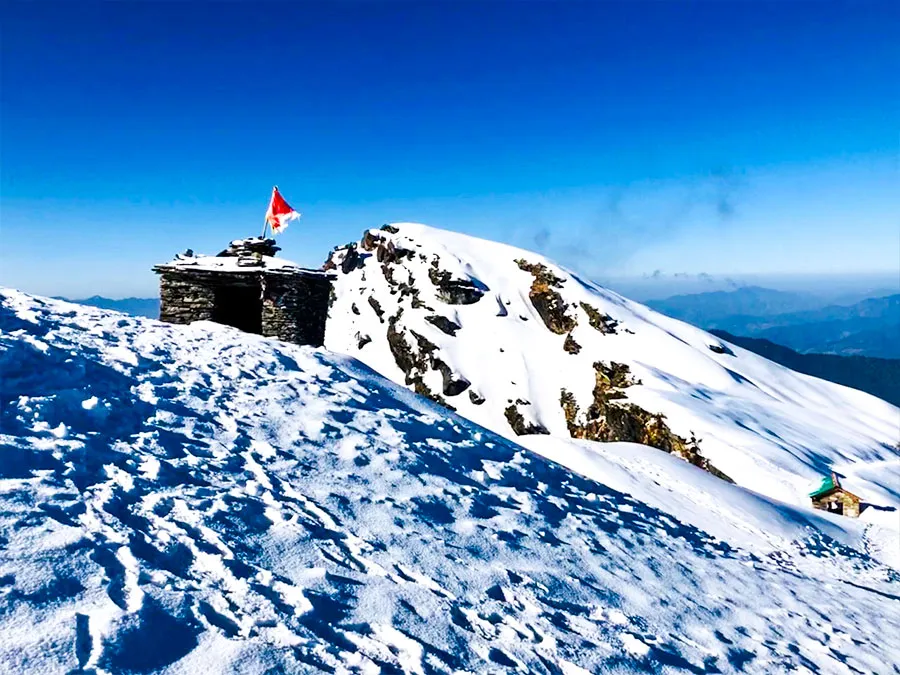
Chopta Tour Package from Delhi – Seasonal Weather Tips
Planning a Chopta tour package from Delhi requires understanding the Chopta weather throughout the year to make your trip safe, comfortable, and unforgettable. Chopta, nestled in the Garhwal Himalayas, offers a variety of experiences — from serene meadows and trekking trails to snow-covered peaks and spiritual sites like the Tungnath Temple. Seasonal knowledge helps travelers choose the best months for trekking, sightseeing, and adventure activities.
Spring (March – May) – The Ideal Time for Trekking
- Weather: Pleasant, cool, and sunny with temperatures between 10°C and 30°C.
- Highlights: Flowers bloom, clear skies, and panoramic views of the Himalayas.
- Activities: The Chopta Tungnath trek and Chandrashila summit trek are ideal during spring. Morning treks offer the best visibility for sunrise views.
- Travel Tip: Perfect for booking a Chopta tour package from Delhi for first-time trekkers and families seeking comfort and scenic beauty.
Monsoon (June – August) – Lush Green Landscapes
- Weather: Moderate to heavy rainfall, temperatures from 12°C to 25°C.
- Highlights: Meandering streams, green meadows, and misty forests.
- Activities: Light trekking and photography; avoid steep trails as they may be slippery.
- Travel Tip: If you enjoy solitude and nature’s freshness, a Chopta tour package from Delhi during monsoon offers a unique, peaceful experience.
Autumn (September – October) – Crystal-Clear Views
- Weather: Stable weather with temperatures from 10°C to 20°C.
- Highlights: Clear skies, visibility of distant snow peaks, and calm weather.
- Activities: Ideal for Chopta Chandrashila trek and Tungnath temple trek.
- Travel Tip: This is one of the best times to visit Chopta, perfect for adventure seekers and photographers.
Winter (November – February) – Snow-Capped Adventure
- Weather: Cold with temperatures between -15°C and 15°C. Heavy snowfall from December to February.
- Highlights: Snow-covered peaks, frozen meadows, and winter wonderland vibes.
- Activities: Chopta Tungnath trek from Delhi and snow trekking; ideal for experienced trekkers.
- Travel Tip: Winter treks require warm clothing, snow boots, and guided Chopta trekking packages for safety. Alternative routes via Deoria Tal may be needed if some roads are blocked.
Key Tips for Booking Your Chopta Tour Package from Delhi
- Check Chopta weather before planning, especially in winter and monsoon.
- Morning treks are preferable for clear Himalayan views.
- Choose guided Chopta trekking packages to ensure safe travel, accommodation, and local expertise.
- Pack according to season — warm clothes for winter, rain protection for monsoon, and light layers for spring and autumn.
With the right planning, a Chopta tour package from Delhi becomes more than a trip — it’s a complete Himalayan adventure. From the peaceful meadows of Chopta to the spiritual aura of Tungnath and the summit of Chandrashila, every moment promises breathtaking views, fresh mountain air, and memories that last a lifetime.
| Month | Temperature | Weather & Highlights | Recommended Activities | Notes / Tips |
|---|---|---|---|---|
| March – May | 10°C – 30°C | Pleasant spring weather, blooming meadows, clear skies | Chopta Tungnath trek, Chandrashila summit trek, trekking, camping, photography | Ideal for first-time trekkers and families. Best time to book Chopta tour package from Delhi. |
| June – August | 12°C – 25°C | Monsoon rains, lush green forests, misty mountains | Light trekking, nature walks, photography | Trails may be slippery. Solo travelers or nature lovers can enjoy quiet landscapes. Chopta trekking packages recommended. |
| September – October | 10°C – 20°C | Clear skies, stable weather, panoramic Himalayan views | Chopta Chandrashila trek, Tungnath temple trek, camping | One of the best times to visit Chopta. Perfect for adventure and photography. |
| November – February | -15°C – 15°C | Heavy snowfall, winter wonderland, frozen meadows | Chopta Tungnath trek from Delhi, snow trekking, winter photography | Recommended for experienced trekkers. Alternative routes via Deoria Tal may be needed. Winter Chopta tour packages ensure safety. |
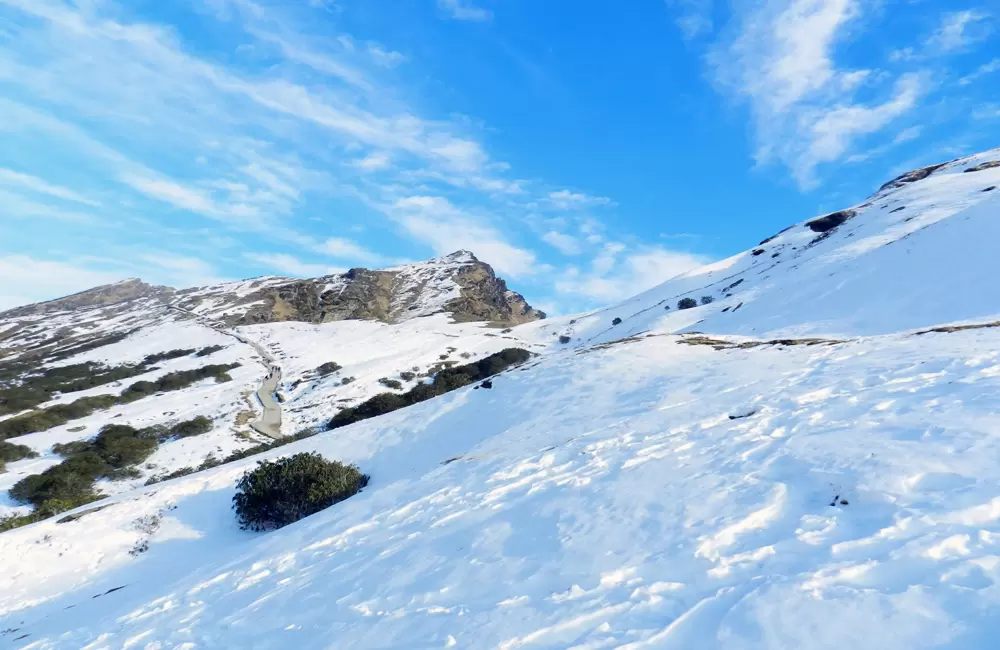
Chopta Weather Overview – When to Book Your Chopta Tour Package
Chopta, nestled in the majestic Garhwal Himalayas, is a paradise for nature lovers, adventure seekers, and spiritual travelers. Its weather changes beautifully with the seasons, giving each visit a unique charm. Understanding the overall Chopta weather helps travelers plan their perfect journey, whether it’s a short Chopta weekend getaway, a thrilling Chopta Tungnath trek, or the iconic Chopta Chandrashila trek.
Spring (March – May) – The Best Time to Visit Chopta
Spring is one of the most popular seasons for trekking in Chopta. Temperatures range from 10°C to 30°C, making it comfortable for outdoor activities.
- Activities: Ideal for Chopta Tungnath trek, Tungnath temple trek, and exploring the meadows.
- Why Visit: Clear skies, blooming flowers, and panoramic Himalayan views. A perfect season for booking a Chopta tour package for first-time visitors or families.
Monsoon (June – August) – Lush Green and Misty Views
Monsoon brings heavy rainfall, with temperatures between 12°C and 25°C. The mountains turn vibrant green, waterfalls flow abundantly, and the air is fresh.
- Activities: Light trekking, photography, and nature walks. Chopta tour packages during this season are ideal for solitude seekers.
- Travel Tip: Trails can be slippery, so it’s best to be cautious while trekking to Tungnath or Chandrashila.
Autumn (September – October) – Clear Skies and Crisp Views
Autumn is considered one of the best times to visit Chopta due to stable weather, moderate temperatures (10°C – 20°C), and clear Himalayan visibility.
- Activities: The Chopta Chandrashila trek and Chopta Tungnath trek are perfect during this season.
- Why Visit: Ideal for adventure enthusiasts, photography, and those looking for a memorable Chopta weekend getaway.
Winter (November – February) – Snow-Capped Adventure
Winter transforms Chopta into a serene snowy wonderland, with temperatures ranging from -15°C to 15°C. Snowfall starts in November and peaks by January, covering the Tungnath temple trek and surrounding trails in white.
- Activities: Snow trekking, winter camping, and adventure trekking. The Chopta Chandrashila trek becomes magical under heavy snowfall.
- Travel Tip: Only experienced trekkers should attempt winter treks. Booking a Chopta tour package during this season ensures guided support and safety.
Planning Your Chopta Tour Package
By understanding the overall Chopta weather, travelers can select the right season for their adventure. Whether you want a short Chopta weekend getaway, a spiritually enriching Tungnath temple trek, or the challenging yet rewarding Chopta Chandrashila trek, timing your trip is key to experiencing Chopta at its best.
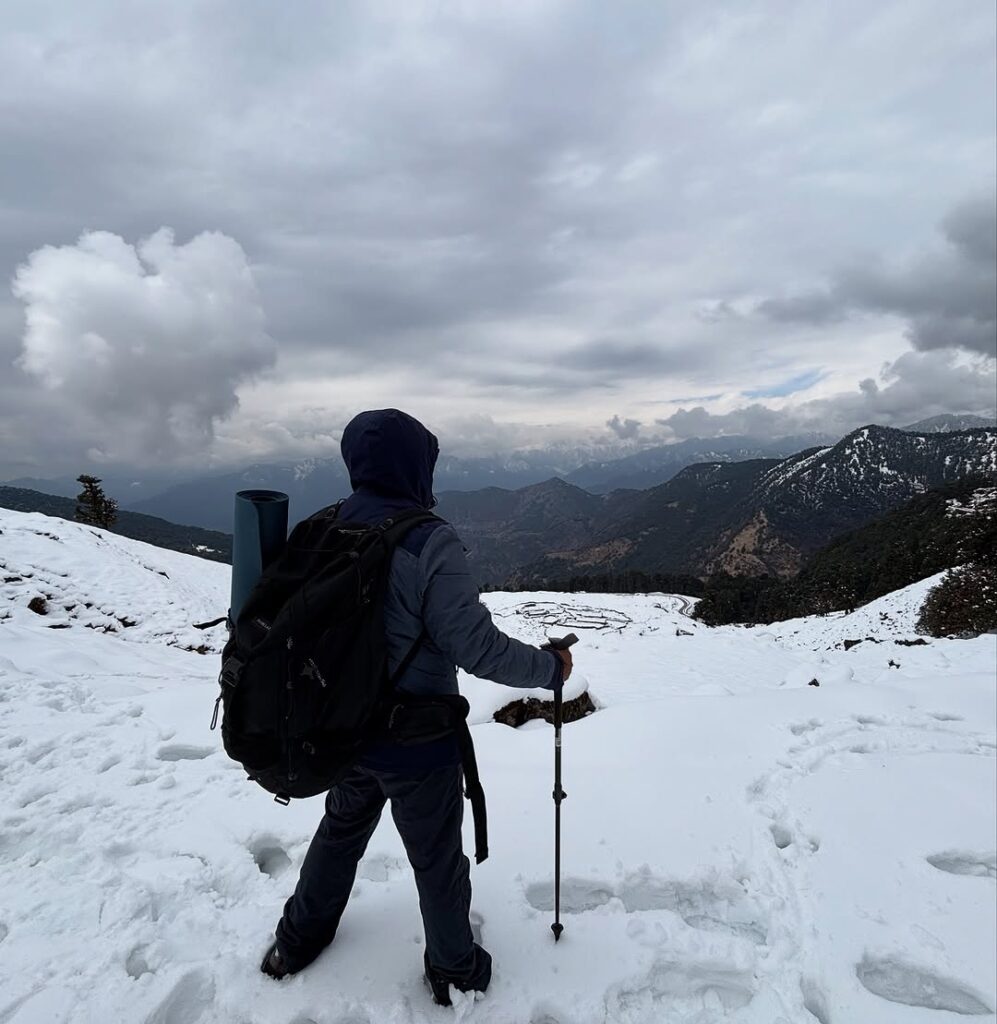
Chopta Tungnath Trek in Winter – Snowfall and Cold Climate Insights
The Chopta Tungnath trek in winter is a magical Himalayan experience that blends adventure, spirituality, and the serene beauty of snow-covered landscapes. This trek, starting from Chopta from Delhi, takes you through dense forests, open meadows, and ultimately to the sacred Tungnath Temple, the highest Shiva temple in the world. Understanding the Chopta weather during winter is crucial to ensure safety and a memorable trekking experience.
Winter Weather Conditions – Cold and Crisp
- Temperatures range from -15°C to 15°C, with the coldest months being December and January.
- Trails and meadows are covered in snow, creating a true winter wonderland for trekkers.
- The sky is often clear during mornings, offering breathtaking panoramic views of the snow-capped Himalayan peaks.
Chopta Snowfall – The Magic of Winter
- Snowfall begins in November and intensifies through December and January, covering the Tungnath temple trek route in thick white layers.
- The snow transforms Chopta into a pristine landscape, ideal for photography, nature walks, and experiencing the tranquility of the Himalayas.
- Heavy snowfall may block some routes, making it important to have alternate paths or a guided Chopta trekking package for safety.
Trekking Experience – Winter Challenges and Rewards
- The trek to Tungnath Temple and onward to Chandrashila requires extra preparation due to icy trails and cold temperatures.
- Proper winter gear, insulated clothing, snow boots, and trekking poles are essential.
- Despite the challenges, the reward is unmatched — snow-laden meadows, frozen streams, and the spiritual ambiance of Tungnath Temple.
Best Time for Winter Trekking – Plan Your Chopta Tour Package
- November to February is the prime winter trekking season for those seeking snow adventures.
- For travelers from the capital, a Chopta Tungnath trek from Delhi during these months offers a unique Himalayan winter experience.
- Booking a Chopta tour package ensures guided support, safe accommodation, and hassle-free transport.
Winter trekking in Chopta is not just a physical journey; it’s a soulful adventure. From crisp mountain air to the spiritual aura of Tungnath Temple, every step of the Chopta Tungnath trek in winter creates memories that last a lifetime.
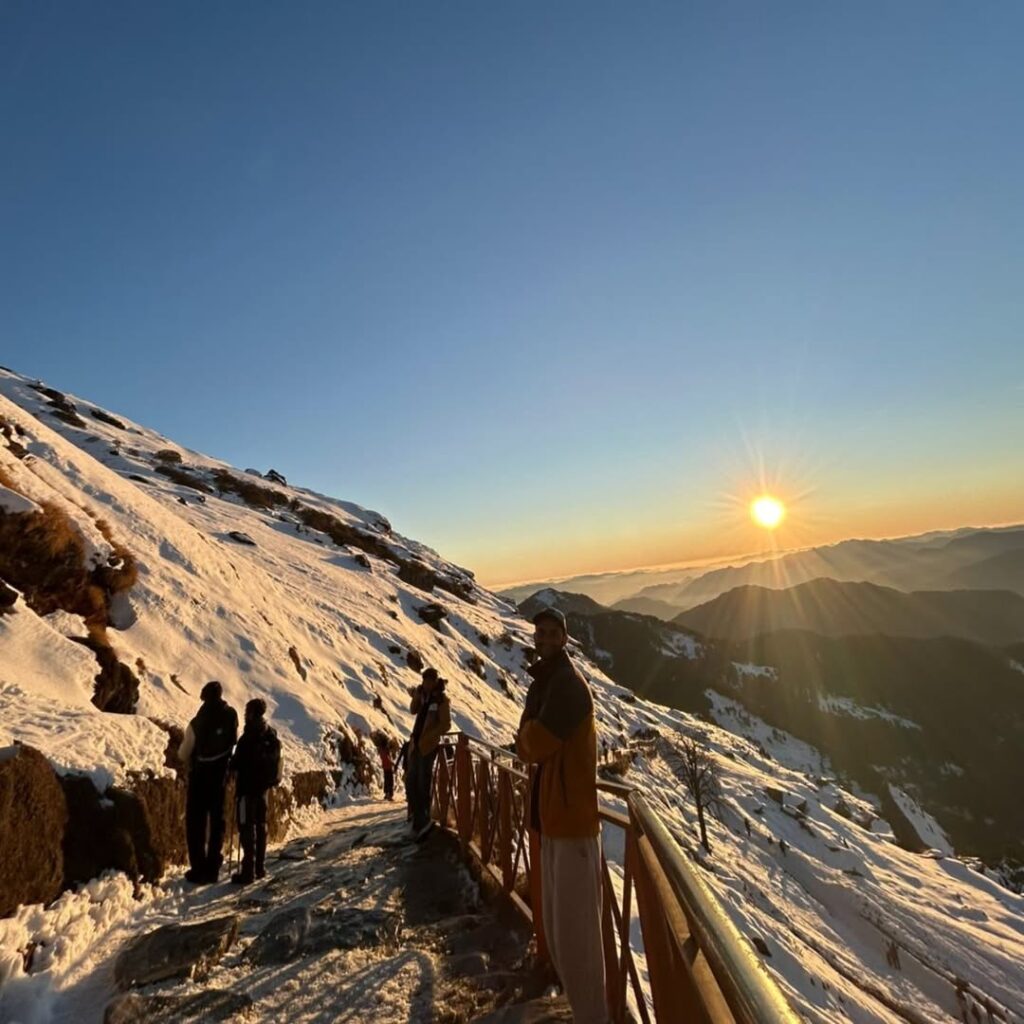
Chopta Trekking Weather Tips – Chopta Tungnath and Chandrashila Experience
Trekking to Chopta, whether it’s the Chopta Tungnath trek or the Chopta Chandrashila trek, is a thrilling Himalayan adventure. However, understanding the Chopta weather and packing smartly is key to a safe and enjoyable journey. Here’s a complete guide on what to pack, season-wise, for your Chopta tour package or Chopta trekking packages from Delhi.
1. Clothing Essentials
- Winter (Nov – Feb): Heavy woolens, down jackets, thermals, gloves, beanies, and scarves. Waterproof trekking shoes or snow boots are a must.
- Spring/Autumn (Mar – May / Sep – Oct): Light woolens, jackets, trekking pants, t-shirts, and a warm layer for early mornings.
- Monsoon (Jun – Aug): Waterproof jackets, quick-dry clothing, trekking shoes with good grip, and rain protection for bags.
2. Trekking Gear
- Sturdy trekking shoes or boots with good ankle support
- Trekking poles for steep or snowy trails
- Backpack with rain cover and compartments for easy access
- Headlamp or flashlight for early morning or evening trekking
3. Personal Items & Essentials
- Sunglasses to protect from snow glare or strong sun
- Sunscreen, lip balm, and moisturizer to prevent dry skin
- Reusable water bottles and hydration packs
- Trekking snacks and energy bars for quick energy
- First-aid kit including bandages, pain relievers, and altitude sickness medicine
4. Snow & Cold-Specific Gear (Winter Trekking)
- Insulated gloves and thermal socks
- Waterproof pants and jackets
- Microspikes or crampons for icy paths
- Extra layers of clothing for unexpected cold snaps
5. Optional Adventure & Comfort Items
- Camera or action cam to capture scenic landscapes
- Binoculars for birdwatching in Chopta
- Sleeping bag if your Chopta tour package includes camping
- Lightweight trekking towel and personal hygiene items
6. Tips for Packing Smart
- Layer your clothing for flexibility across changing temperatures
- Avoid carrying heavy luggage; keep essentials in a small daypack
- Always check Chopta weather before departure to adjust clothing and gear
- If booking a Chopta tour package from Delhi, confirm what gear is provided and what you need to bring
By packing carefully and planning according to the Chopta trekking weather, your Chopta Tungnath and Chandrashila experience becomes safe, enjoyable, and unforgettable. From snow-capped meadows to sunrise views at the Chandrashila summit trek, proper preparation ensures every moment is memorable.
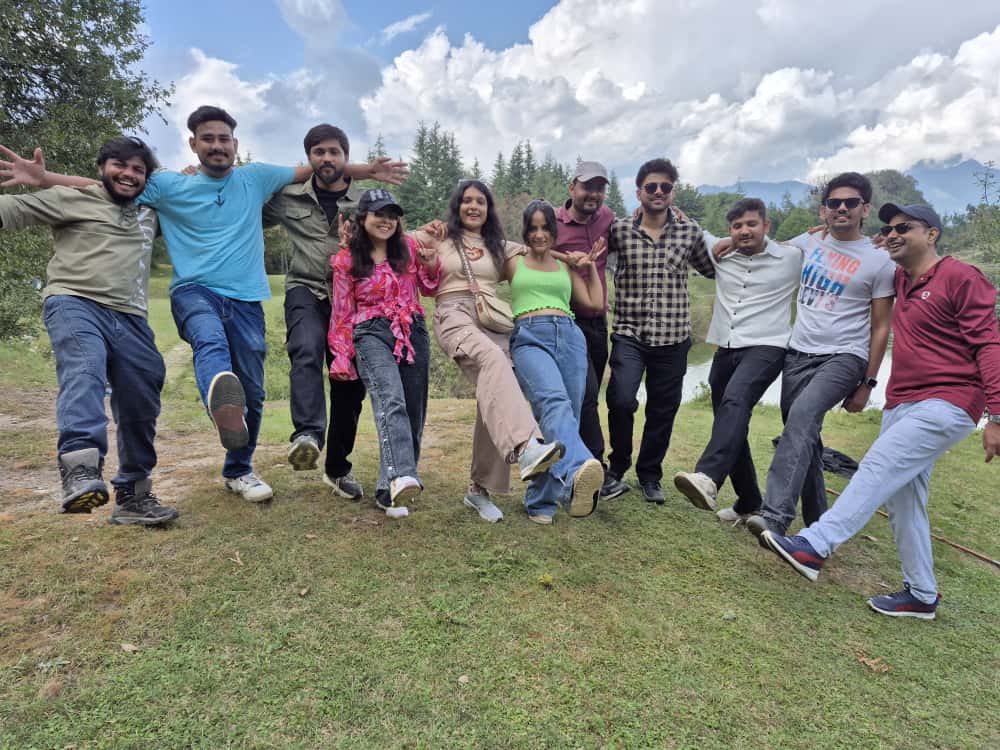
Frequently Asked Questions:
1. What is the best time to visit Chopta for trekking?
The ideal time for trekking in Chopta is during the winter months, from December to February. This period offers clear skies, snow-covered trails, and breathtaking Himalayan views. Be prepared for cold temperatures and potential snowfall
2. What is the difficulty level of the Chopta Chandrashila trek?
The Chopta Chandrashila trek is considered easy to moderate, making it suitable for beginners and seasoned trekkers alike. The trail is well-defined, but proper winter gear is necessary due to snow and cold temperatures
3. How can I reach Chopta from Delhi?
Chopta is approximately 450 km from Delhi. You can reach Chopta by road via Rishikesh and Rudraprayag, with a journey time of around 10–12 hours. Alternatively, take a train to Haridwar or Rishikesh and then hire a taxi to Chopta
4. Are there any guided trekking packages available?
Yes, several operators offer guided trekking packages to Chopta. These include transport, accommodation, meals, and an experienced guide, making it convenient and safe for winter trips
5. What is included in a typical Chopta trekking package?
A standard Chopta trekking package usually includes:
- Transportation from Delhi to Chopta and back
- Accommodation in camps or guesthouses
- Meals (breakfast, lunch, dinner)
- Trekking permits if required
- Guide services
- First aid kit
6. What are the accommodation options in Chopta?
Chopta offers various accommodation options, including:
- Swiss tents with basic amenities
- Cottages with attached bathrooms
- Homestays for an authentic local experience
Many packages include accommodation, meals, and trekking activities for a hassle-free trip
7. Is Chopta suitable for solo travelers?
Yes, Chopta is a popular destination for solo travelers. The trekking routes are safe, and many operators offer packages tailored for solo adventurers. Joining a group trek can also be a great way to meet fellow travelers
8. What should I pack for a winter trek in Chopta?
Essential items to pack include:
- Thermal wear (top and bottom)
- Waterproof trekking shoes
- Woolen socks, gloves, and caps
- Windproof and waterproof jacket
- Sunglasses
- Headlamp or flashlight
- Personal medications
- Snacks and first aid kit
9. Are there any camping packages available in Chopta?
Yes, camping packages are available, including accommodation, meals, and fun activities like bonfires and stargazing
10. What is the cost of a Chopta trekking package?
The cost varies depending on the package and duration. Budget-friendly options start from around ₹4,500–₹5,000 per person for standard packages covering transport, stay, meals, and guided treks

